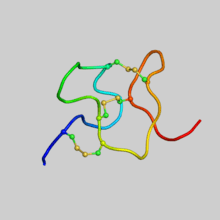Heteropodatoxin
Heteropodatoxins are peptide toxins from the venom of the giant crab spider Heteropoda venatoria, which block Kv4.2 voltage-gated potassium channels.

Sources
Heteropodatoxins are purified from the venom of the giant crab spider, Heteropoda venatoria (Sanguinetti 1997).
Chemistry
Heteropodatoxins contain an Inhibitor Cystine Knot (ICK) motif, which consist of a compact disulfide-bonded core, from which four loops emerge (Bernard 2000). There are three different heteropodatoxins (Sanguinetti 1997):
- heteropodatoxin-1, also known as Toxin AU3/KJ5 or HpTx1
- heteropodatoxin-2, also known as Toxin KJ6 or HpTx2
- heteropodatoxin-3, also known as Toxin AU5C/KJ7 or HpTx3
These three toxins are structurally similar peptides of 29-32 amino acids (Sanguinetti 1997). They show sequence similarity to Hanatoxins, which can be isolated from the venom of the Chilean rose tarantula Grammostola rosea (Sanguinetti 1997).
Target
Heteropodatoxins block A-type, transient voltage-gated potassium channels. All three toxins have been shown to block the potassium channel Kv4.2 (Sanguinetti 1997). Recombinant heteropodatoxin-2 blocks the potassium channels Kv4.1, Kv4.2 and Kv4.3, but not Kv1.4, Kv2.1, or Kv3.4 (Zarayskiy 2005).
Mode of action
Heterpodatoxin-2 most likely acts as a gating modifier of the Kv4.2 channels (Zarayskiy 2005). It shifts the voltage dependence of the activation and the inactivation of the Kv4.3 potassium channel to more positive values. As a result, in the presence of the toxin this channel has a higher probability of being inactivated and a larger depolarization is needed to open the channel. However, heterpodatoxin-2 did not affect the voltage dependence of the Kv4.1 channel, suggesting that the precise mechanism of block remains to be elucidated (Zarayskiy 2005) and a role as a pore blocker cannot be excluded (Bernard 2000). The voltage dependence of Kv4.2 block varies among the three different heteropodatoxins. It is less voltage dependent for HpTx1 than for HpTx2 or HpTx3 (Sanguinetti 1997).
Toxicity
The giant crab spider can cause a locally painful bite.[1]
Footnotes
- Edwards, G. B. (2009). "huntsman spider - Heteropoda venatoria (Linnaeus)". Featured Creatures. Retrieved May 11, 2009.
References
Bernard C, Legros C, Ferrat G, Bischoff U, Marquardt A, Pongs O, Darbon H (2000). "Solution structure of hpTX2, a toxin from Heteropoda venatoria spider that blocks Kv4.2 potassium channel". Protein Sci. 9 (11): 2059–67. PMC 2144494. PMID 11152117.
Sanguinetti MC, Johnson JH, Hammerland LG, Kelbaugh PR, Volkmann RA, Saccomano NA, Mueller AL (1997). "Heteropodatoxins: peptides isolated from spider venom that block Kv4.2 potassium channels". Mol. Pharmacol. 51 (3): 491–8. PMID 9058605.
Zarayskiy VV, Balasubramanian G, Bondarenko VE, Morales MJ (2005). "Heteropoda toxin 2 is a gating modifier toxin specific for voltage-gated K+ channels of the Kv4 family". Toxicon. 45 (4): 431–42. doi:10.1016/j.toxicon.2004.11.015. PMID 15733564.